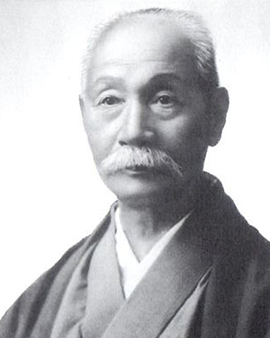Kusakabe Kimbei has always been interested in photography, which made him move to another city. There he made it his profession and opened his own photo studio, named K. Kimbei, in which he offered souvenir photographs.
His focus was mainly on portraying women. But not just any women: in particular, he posed and photographed geishas.
Kusakabe Kimbei was not only a Japanese photographer. He is considered one of the most important producers of souvenir photographs in Japan, late 19th century. Already as a young man, he said goodbye to his native city of Kōfu to go to Yokohama. This was because this city was not only the center of tourism at the time, but also flourished to become the center of Japanese photography. However, since he did not yet have a reputation and was completely unknown in this city, he first worked as a colorist who carefully painted the photographs of more important photographers. Eventually he became an assistant to photographer Felice Beato, who established the stylistic standards of Yokohama souvenir photography.
For some time he worked with Beato and other photographers until he opened his own photography studio under the name K. Kimbei. There he created a catalog that contained over 2000 souvenir photographs, though not all of them were shot by him. He also carried photographs of Beato, among others, in order to reach and retain as many customers as possible. However, he also used the exhibition of other people's photographs to have enough time to shoot and colorize his own images.
The vast majority of the photographs immortalized in the catalog are views of popular destinations in Japan, which were naturally particularly popular with customers. However, 416 images depict the customs of Japan, which were often depicted of Japanese women performing various activities - a common subject for souvenir photography. "Decent" women who did not work in public, however, refused to be photographed. The realistic image was considered too sensual, making the woman's body available to the customer, which was consequently considered unseemly. In addition, there were some superstitious beliefs that being photographed did something to the soul and sucked it out of the body. Accordingly, all the models Kimbei staged and photographed were women working in public, like geishas. However, he portrayed them in a rather conservative and old-fashioned way, while in Japan the change of the Japanese body image was taking place. And he was not impressed by the Western influences either. Instead, he had them pose in a way that represented women of different social classes.
×





.jpg)
.jpg)
.jpg)
.jpg)
.jpg)
.jpg)
.jpg)
.jpg)
 - (MeisterDrucke-225369).jpg)
 - (MeisterDrucke-225369).jpg)
.jpg)
.jpg)
 - (MeisterDrucke-159304).jpg)
 - (MeisterDrucke-159304).jpg)
.jpg)
.jpg)
_Japanese_Girl_Playing_Game_c1880_-_(MeisterDrucke-390226).jpg)
_Japanese_Girl_Playing_Game_c1880_-_(MeisterDrucke-390226).jpg)
.jpg)
.jpg)
.jpg)
.jpg)
.jpg)
.jpg)
 - (MeisterDrucke-190421).jpg)
 - (MeisterDrucke-190421).jpg)
.jpg)
.jpg)
 - (MeisterDrucke-368924).jpg)
 - (MeisterDrucke-368924).jpg)
_-_(MeisterDrucke-312201).jpg)
_-_(MeisterDrucke-312201).jpg)
.jpg)
.jpg)
_-_(MeisterDrucke-245341).jpg)
_-_(MeisterDrucke-245341).jpg)
_with_a_sailing_boat_in_the_foreground_on_Lake_-_(MeisterDrucke-1427942).jpg)
_with_a_sailing_boat_in_the_foreground_on_Lake_-_(MeisterDrucke-1427942).jpg)
 - (MeisterDrucke-16441).jpg)
 - (MeisterDrucke-16441).jpg)
.jpg)
.jpg)
.jpg)
.jpg)
.jpg)
.jpg)
.jpg)
.jpg)
.jpg)
.jpg)
.jpg)
.jpg)
.jpg)
.jpg)
.jpg)
.jpg)
.jpg)
.jpg)
![Album. [Japanese Album: Portraits, Group Portraits, Occupations, and Views, Plus Some in Ceylon & India] by Kusakabe Kimbei Album. [Japanese Album: Portraits, Group Portraits, Occupations, and Views, Plus Some in Ceylon & India] by Kusakabe Kimbei](/kunstwerke/300px/Kusakabe_Kimbei_-_Album_(spine_title)_Japanese_Album_portraits_group_portraits_occupations_and_vie_-_(MeisterDrucke-1591319).jpg)
![Album. [Japanese Album: Portraits, Group Portraits, Occupations, and Views, Plus Some in Ceylon & India] by Kusakabe Kimbei](/kunstwerke/400w/Kusakabe_Kimbei_-_Album_(spine_title)_Japanese_Album_portraits_group_portraits_occupations_and_vie_-_(MeisterDrucke-1591319).jpg)
.jpg)
.jpg)
.jpg)
.jpg)
.jpg)
.jpg)
.jpg)
.jpg)
.jpg)
.jpg)
.jpg)
.jpg)
.jpg)
.jpg)
.jpg)
.jpg)
.jpg)
.jpg)
.jpg)
.jpg)
.jpg)
.jpg)
.jpg)
.jpg)
_Japanese_Girl_Playing_Game_-_(MeisterDrucke-1589716).jpg)
_Japanese_Girl_Playing_Game_-_(MeisterDrucke-1589716).jpg)
.jpg)
.jpg)
.jpg)
.jpg)
.jpg)
.jpg)
.jpg)
.jpg)
.jpg)
.jpg)
.jpg)
.jpg)
 c1880 (albumen print with original hand- - (MeisterDrucke-231593).jpg)
 c1880 (albumen print with original hand- - (MeisterDrucke-231593).jpg)
.jpg)
.jpg)
.jpg)
.jpg)
.jpg)
.jpg)
.jpg)
.jpg)






